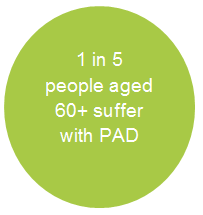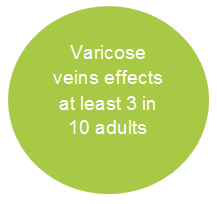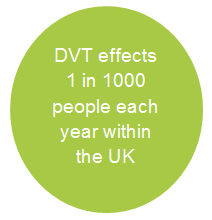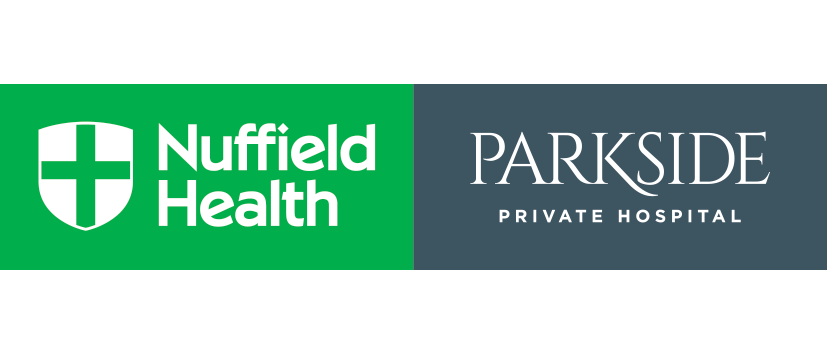The Leg Effect of Vascular Disease
Vascular disease accounts for 40% of deaths in the UK and is preventable, yet so many individuals know little to nothing about the illness. September is Vascular Disease Month, so we’re sharing some information and facts on the illness and tips to prevent it from affecting you!
What is vascular disease?
The vascular system is the body’s network of blood vessels. It includes the arteries, veins and capillaries which carry blood to and from the heart. Vascular disease is caused by the inflammation and weakness of the veins and arteries and the build-up of fatty deposits (often referred to as plaque) within the blood vessels and can therefore effect every part of your body in which the blood flows.
What causes vascular disease?
A build-up of fatty deposits narrows the arteries, and over time, this causes the arteries to be so narrow that the blood flow to vital organs and muscles is restricted causing tissue death, pain and reduced mobility. This build up of fatty deposits is often associated with smoking, poor diets and lack of exercise.
Vascular disease is also commonly found to lead to coronary heart disease and heart attack, furthermore a build-up of plaque in your carotid arteries (supplying blood to your brain) could lead to stroke.
The good news is, it can be prevented – Losing weight, eating healthy foods, being active and not smoking can help vascular disease. Other treatments include medicines and surgery.

Peripheral Arterial Disease (PAD), Varicose Veins and Deep Vein Thrombosis (DVT) are all common types of vascular disease.

PAD is one of the most common forms of vascular disease affecting the arteries in your legs.  It usually develops when plaque builds up on the walls of your arteries (atheroma), causing them to narrow, restricting the blood flow from the heart to the muscles.
It usually develops when plaque builds up on the walls of your arteries (atheroma), causing them to narrow, restricting the blood flow from the heart to the muscles.

Some people with peripheral arterial disease will experience no symptoms; however others will notice pain, almost like a cramp in your leg/calf/buttocks, when they start to exercise due to the muscles not getting enough blood. This pain will usually go away quickly when you stop exercising. Other symptoms include:
- Numb or cold feet and toes
- Loss of hair from your toes, feet or legs
- Sores on your toes, feet or legs that won’t heal
For more information on PAD or to book a consultation call 020 8971 8026

Varicose veins develop when the blood isn’t flowing properly through the veins in your legs. You  have two main types of veins in your legs; superficial veins near the surface and deep veins within your muscles. Usually, the blood will flow from the superficial veins to the deep veins, and then back to your heart. In order to ensure that your blood travels in the right direction, there are ‘one-way’ valves inside your veins. However if the blood deep inside your leg is under more pressure than the blood in the surface veins, one of these values may leak enabling the blood to go in the opposite direction, from your deep veins to your superficial veins. This results in a build-up of blood in the superficial veins, making them swell and bulge which is known as varicose veins.
have two main types of veins in your legs; superficial veins near the surface and deep veins within your muscles. Usually, the blood will flow from the superficial veins to the deep veins, and then back to your heart. In order to ensure that your blood travels in the right direction, there are ‘one-way’ valves inside your veins. However if the blood deep inside your leg is under more pressure than the blood in the surface veins, one of these values may leak enabling the blood to go in the opposite direction, from your deep veins to your superficial veins. This results in a build-up of blood in the superficial veins, making them swell and bulge which is known as varicose veins.
.png)
Varicose veins are swollen veins that you can see and often feel, lying under your skin. They usually affect your legs. Varicose veins are more common in women and you’re more likely to get them the older you are. Although they can be unsightly, for most people varicose veins don’t cause problems. Common symptoms include:
- Aching or heaviness in your legs
- Itchy or burning feeling in the skin over the veins
- Restless legs
- Swollen feet and ankles – especially after standing for a long time
- Cramps in your legs – usually at night
- Lumps or bulging veins
- Changes in the skin colour, and skin ulcers
If you do have symptoms there are a range of procedures that can help your legs to look and feel better. You may find your symptoms are helped by putting your leg up. If you’re a woman you may find that your symptoms are worse during your period or pregnancy. These symptoms may be caused by problems other than varicose veins. If you have any of these symptoms, contact your GP for advice. For more information on varicose veins and to see our expert consultants click here.

Deep vein thrombosis (DVT) is a condition where a blood clot forms in one of your deep veins, usually the leg. DVT can cause pain and swelling and may lead to complications, such as pulmonary embolism if the blood clot dislodged and travelled to your lungs.
DVT is most common in the deep veins of your lower leg (calf). Deep veins pass through the centre of your leg and are surrounded by layers of muscle. DVT happens when a blood clot forms in one of these deep veins. DVT can also develop in the deep veins in your thigh and, more rarely, in other deep veins, such as the ones in your arms or pelvis. Sometimes blood clots can form in your superficial veins, known as superficial thrombophlebitis. The condition is different to DVT and much less serious, but it can occasionally spread to your deep veins.

Most blood clots are small and don’t cause any symptoms. Your body will often be able to gradually break them down and there won’t be any long-term effects to your health. Larger clots can be more of a problem as they can partly or completely block the blood flow in your vein.
- Swelling
- Pain and tenderness
- Warm skin that looks red
- A mild fever
If you have any of these symptoms, contact your GP as soon as possible. For more information on our vascular surgery or to book a consultation with one of our friendly orthopaedic consultants see here.
Disclaimer:
This information is intended solely for the general information of the reader and is not a substitute for medical care provided by a licensed and qualified health professional. Please consult your GP/health care provider for a formal diagnosis.
Date: 16/09/2016



 It usually develops when plaque builds up on the walls of your arteries (atheroma), causing them to narrow, restricting the blood flow from the heart to the muscles.
It usually develops when plaque builds up on the walls of your arteries (atheroma), causing them to narrow, restricting the blood flow from the heart to the muscles.

 have two main types of veins in your legs; superficial veins near the surface and deep veins within your muscles. Usually, the blood will flow from the superficial veins to the deep veins, and then back to your heart. In order to ensure that your blood travels in the right direction, there are ‘one-way’ valves inside your veins. However if the blood deep inside your leg is under more pressure than the blood in the surface veins, one of these values may leak enabling the blood to go in the opposite direction, from your deep veins to your superficial veins. This results in a build-up of blood in the superficial veins, making them swell and bulge which is known as varicose veins.
have two main types of veins in your legs; superficial veins near the surface and deep veins within your muscles. Usually, the blood will flow from the superficial veins to the deep veins, and then back to your heart. In order to ensure that your blood travels in the right direction, there are ‘one-way’ valves inside your veins. However if the blood deep inside your leg is under more pressure than the blood in the surface veins, one of these values may leak enabling the blood to go in the opposite direction, from your deep veins to your superficial veins. This results in a build-up of blood in the superficial veins, making them swell and bulge which is known as varicose veins..png)


